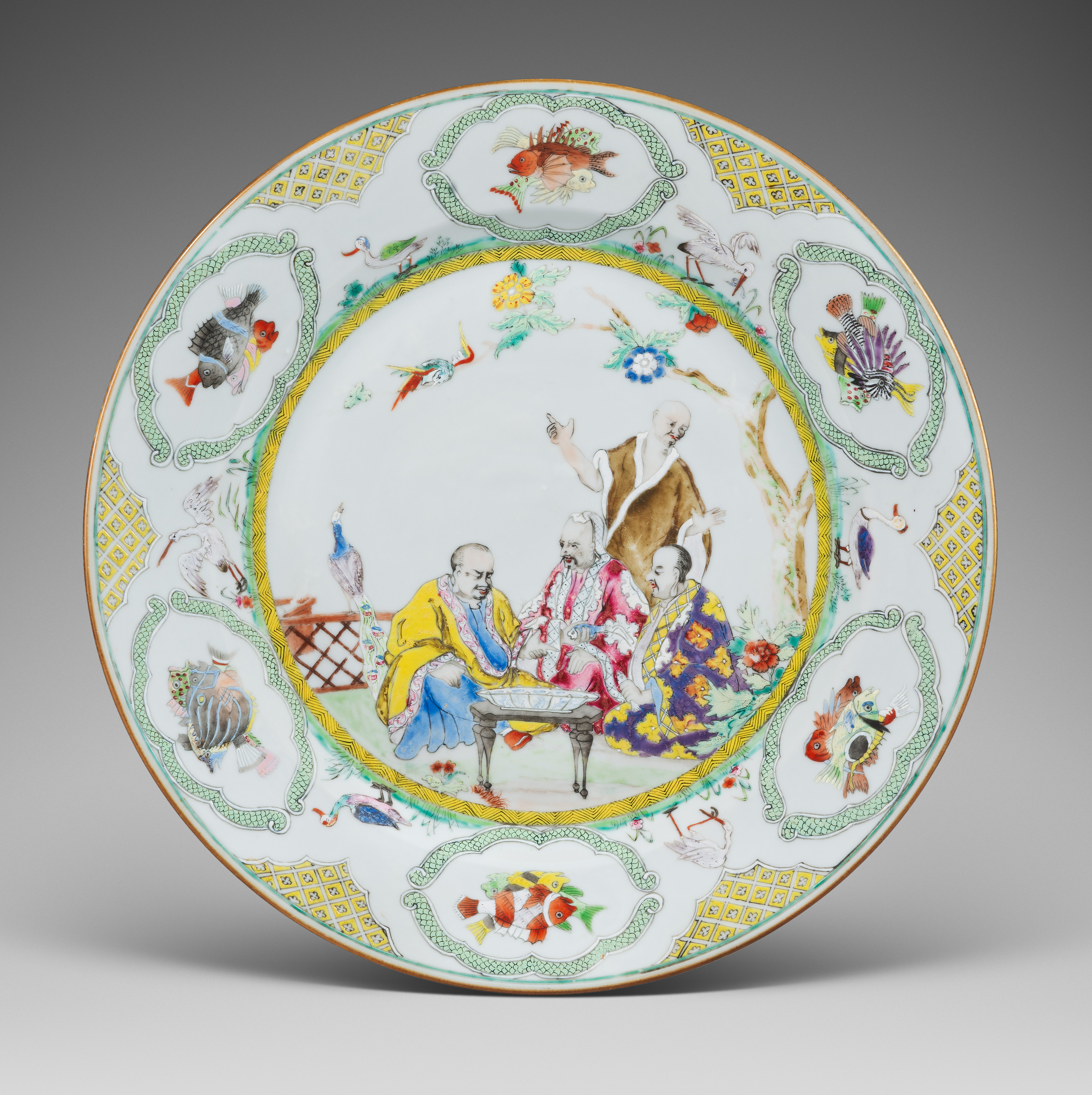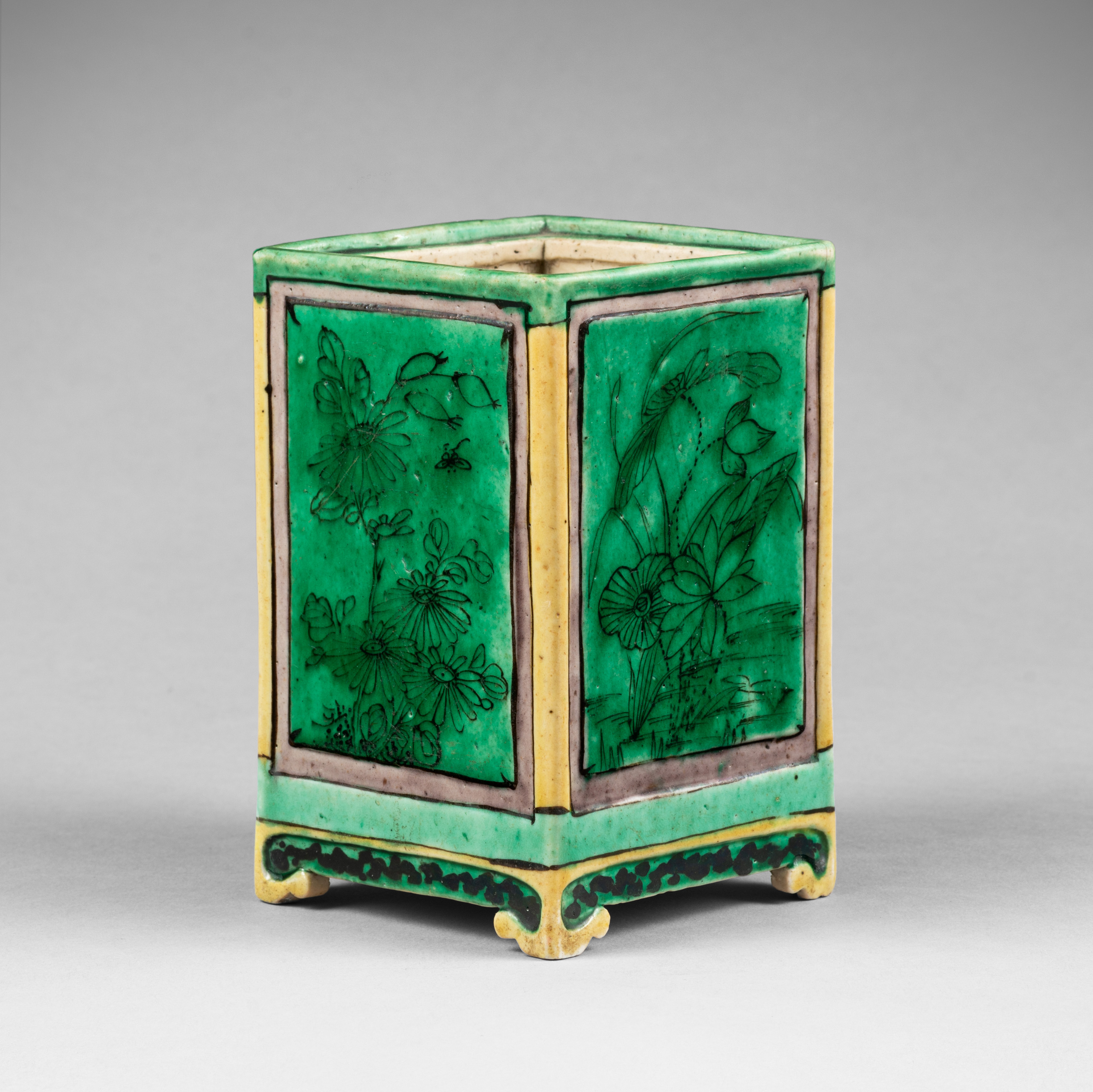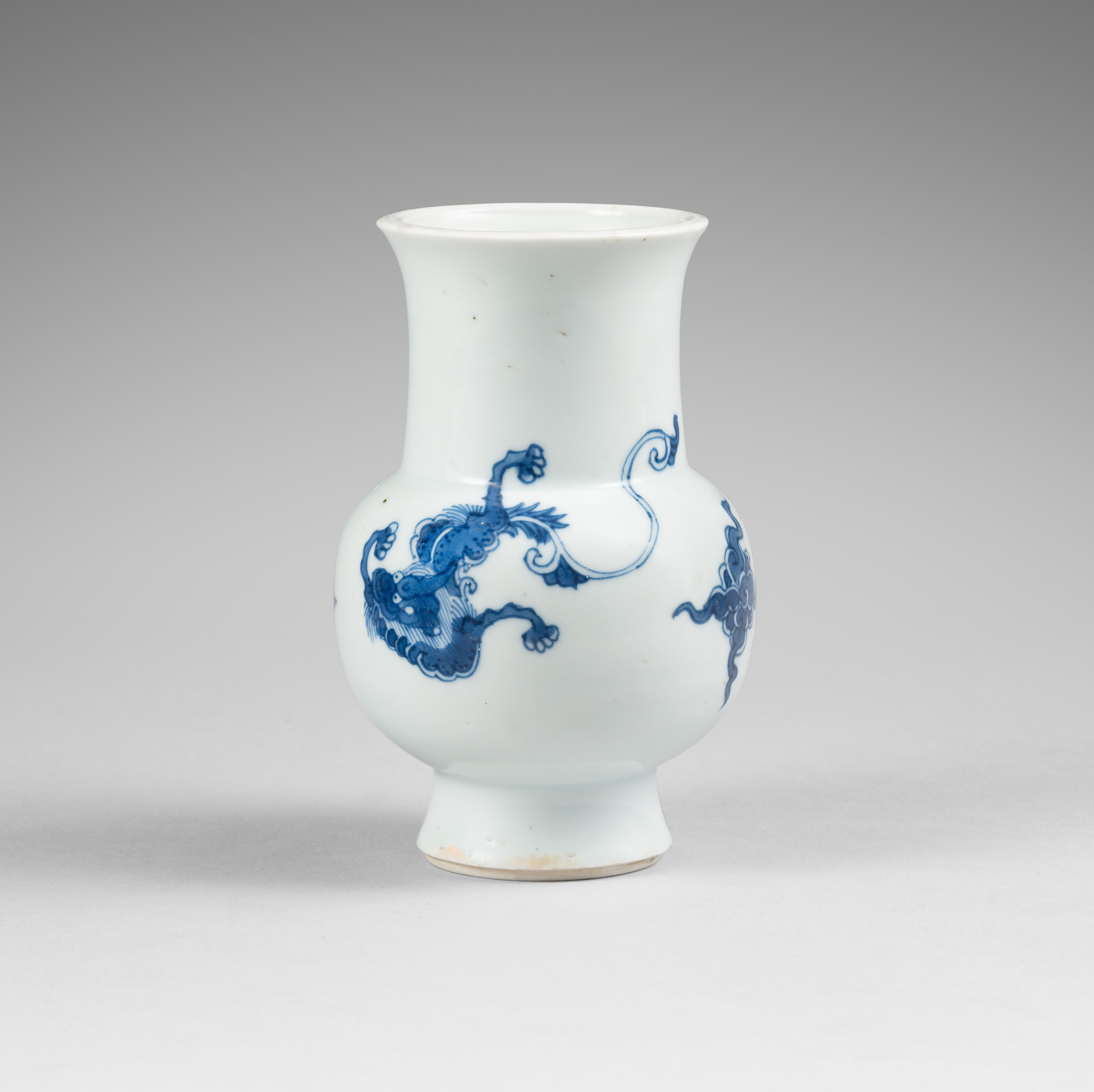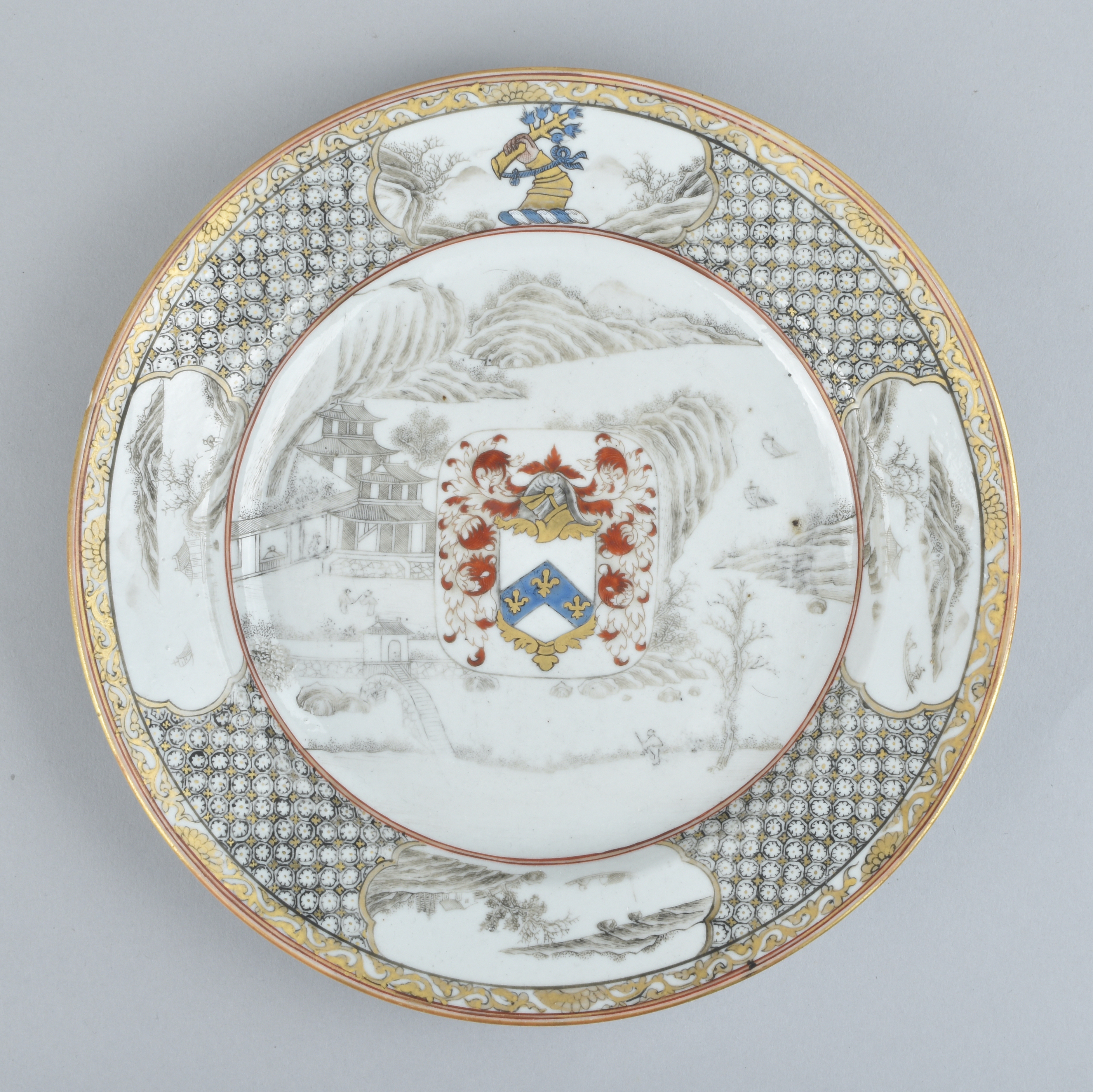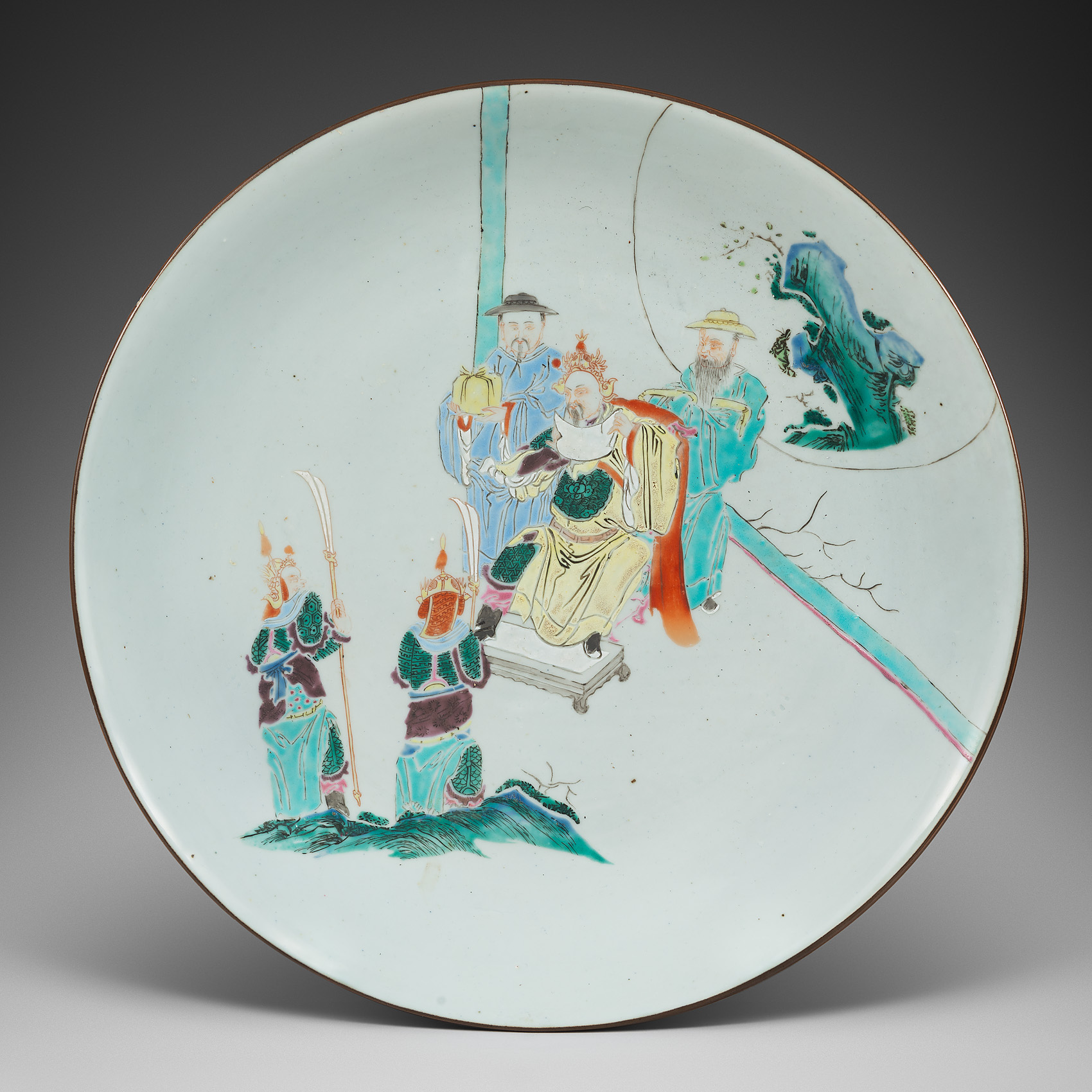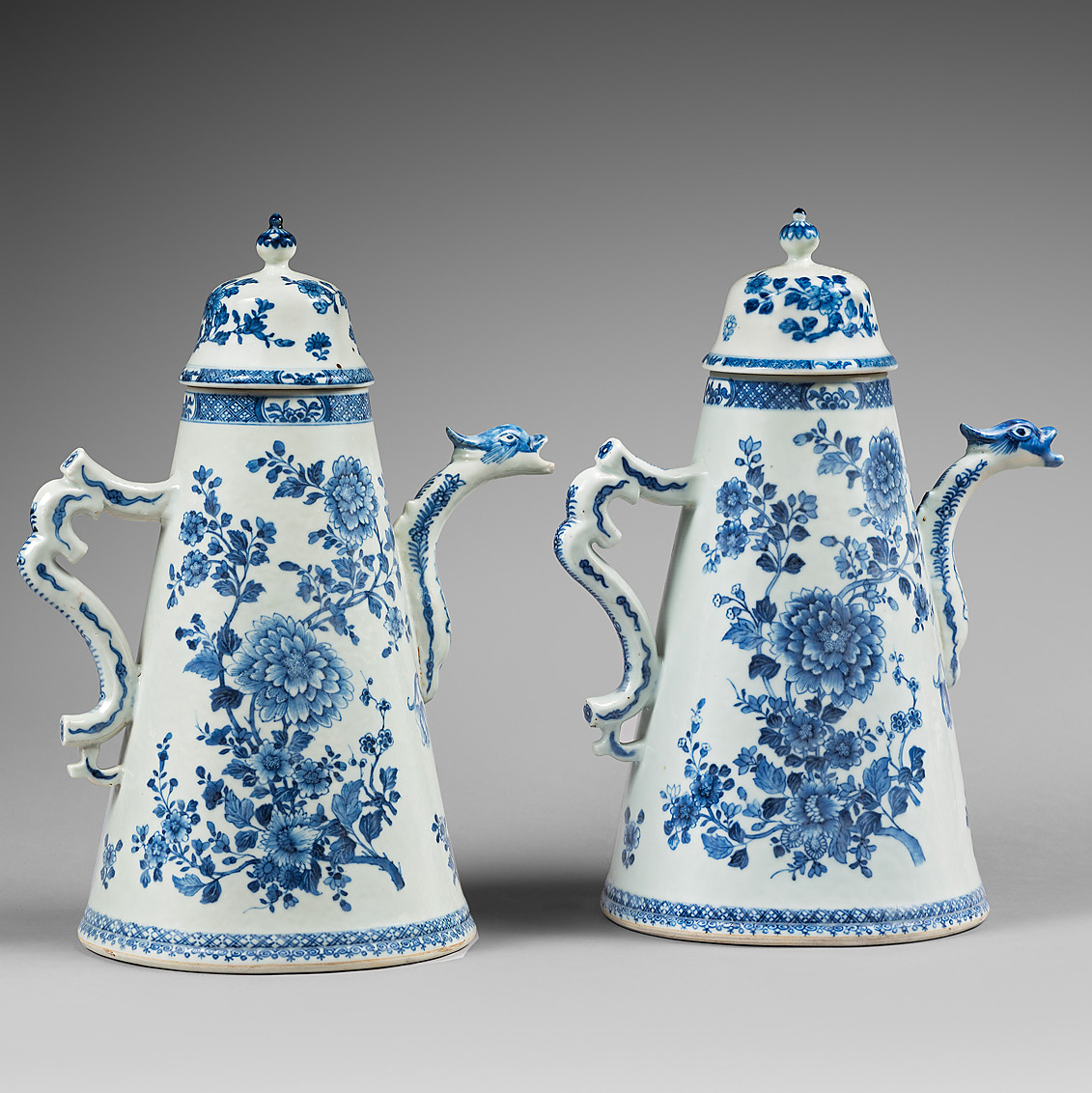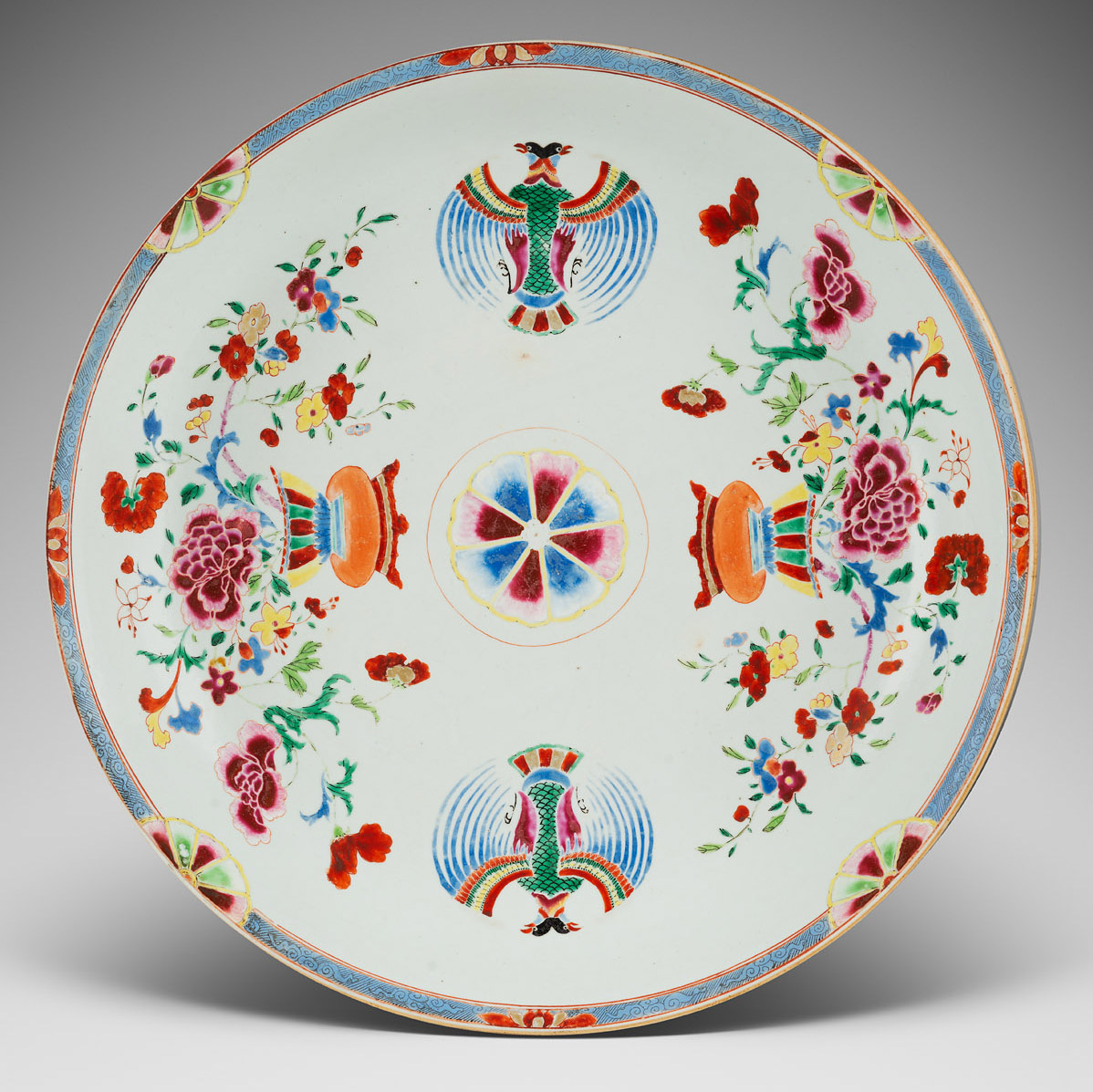
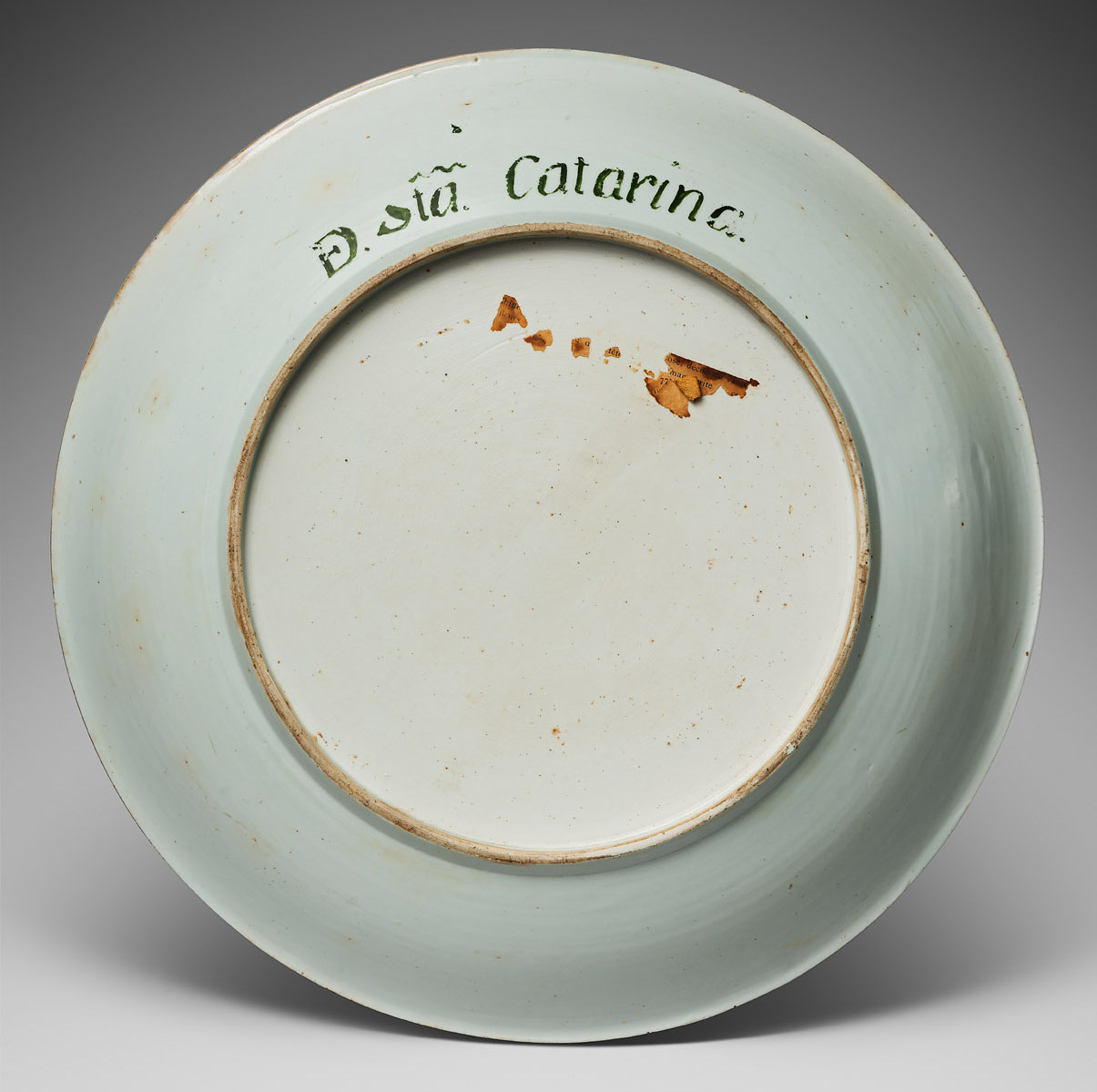
A very large and rare Chinese famille rose dish for the New Spain / Mexican market
A Chinese export famille rose porcelain dish decorated in vibrant enamels depicting two double-headed eagles flanked by a wide as- sortment of flowers made for the Mexico market. Two floral arrange- ments are potted in large footed bowls decorated in vertical stripes that mirror the color schemes of the wings of each eagle. A large floral medallion occupies the center, with additional half medallions interrupting a blue border.
- Country:
- China
- Period :
- Qianlong period (1736-1795), c. 1740
- Material:
- Porcelain
- Dimension:
- 15.15 in. (38,5 cm )
- Reference :
- D542
- Status:
- sold
Provenance
A french private collection of the South of France
Related works
Photography : Jérémie Beylard / Agence PHAR
Notice
By John Guerrero, independant researcher
Santa Catarina and the Order of St. Augustine in New Spain
The double-headed eagles are derived from the Hapsburg eagle–the use of which was apparently granted to the Spanish Order of Saint Augustine for use in the Philippines by Phillip II of Spain (1556-1598) in 1565 after the “discovery” of an image of the Santo Niño de Cebu—a twelve inch tall dark wood carving of the Child Jesus in the Flemish style.[1]
Generally, the legend of the Santo Niño de Cebu provides that the Santo Niño was first given as a gift from Conquistador Ferdinand Magellan to the native Filipino leader of Cebu, Rajah Humabon, and his wife in 1521 upon their Christian conversion.[2] Incidentally, Magellan also promised Rajah that he would “vanquish all his enemies” and make him king of all other chiefs if he were to be baptized a Christian and accept the King of Spain as his own.[3] While this threat sufficed to suppress a great number of chiefs, leading to thousands of Christian converts, the native Filipino leader Lapu-Lapu of the neighboring island of Mactan refused to bend the knee to Magellan and Rajah.[4] Magellan sailed just 49 conquistadores to confront Lapu-Lapu and his thousand man army, relying on superior European armor.[5] Magellan was slain at the Battle at Mactan when his armor proved ineffective against the flurry of hardened bamboo lances, stakes, stones, and poisoned arrows.[6] Lapu-Lapu is celebrated as the first Filipino hero for leading the country’s first resistance against Spanish colonialization.[7] The Santo Niño was “lost” immediately following the Battle of Mactan in April 1521.
Conversely, Conquistador Hernán Cortés experienced more favorable outcomes conquering the Aztec Empire, thanks in large part to a different kind of European armor—immunity to smallpox that decimated the indigenous populations. By the end of August 1521, the Aztec Empire fell, the Aztec people were massacred, and the Aztec capital of Tenochtitlan razed to the ground, yet this was precisely where the Spanish capital of New Spain would be founded. Cortés immediately turned to subjugation of the indigenous populations in the form of spiritual conquest. The three battalions that made up this army of the Cross were the Franciscans, the Domincans, and the Augustinians.[8] The first seven Augustinian friars arrived in New Spain around 1533.[9] For the next fifty years, the three Orders would found dozens of friaries, convents, and missions to mass convert the indigenous population throughout New Spain, in Mexico and beyond.[10]
After Magellan, the Philippines resisted Spanish colonialism for another 44 years, until the arrival of Conquistador Miguel Lopes de Legaspi in 1565.[11] Upon arrival, the Santo Niño de Cebu was rediscovered inside the home of a native Cebuano—that the Santo Niño had a continuous presence in the Philippines throughout the 44 years since Magellan was framed as proof that God predestined the Philippines to Catholicism.[12]
Legaspi was joined by Augustinian Friar Andrés de Urdaneta who led four other friars. The Augustinian friars were quick to notify Phillip II that the rediscovered Santo Niño was “from the time of Magellan” and that its discovery was evidence that Cebu must be decisively conquered by the Spanish.[13] The circumstances leading to the rediscovery of the Santo Niño, as recounted by Legaspi, has been met with skepticism.[14] However, it remains that the Santo Niño is the earliest Christian artifact in the Philippines, and to many, is one of the most revered shrine images to this day. Regardless, the Spanish used it to justify its permanent occupation of the Philippines for the next three centuries.[15]
Prior to donning the Augustinian habit, Urdaneta was a soldier in Italy and an experienced ship-captain and explorer.[16]Urdaneta leveraged his background to locate an easterly current across the North Pacific, and established a new trade route from the Philippines back to Acapulco, Mexico, which made colonization of the Philippines feasible.[17] The contributions of Urdaneta undoubtedly played a role in Phillip II granting the Spanish Order of Saint Augustine the use of the Hapsburg double-headed eagle. As a result, Legaspi was able to establish the first Spanish settlement in Cebu in 1565, and a second settlement in Manila in 1571, which became the center of the Spanish colony.[18]
Coincidentally, shortly after Spanish settlement in Manila in 1571, a Chinese junk started taking on water off the coast of Mindoro, just south of Manila Bay.[19] The Spanish rescued the Chinese sailors and returned their cargo to them, which impressed them so much that they promised to return with more merchandise.[20] The following year, three Chinese merchants from Fujian returned to Manila with damask, silks, and porcelain, and returned regularly with merchandise in subsequent years, supplying cargoes for the Manila Galleons.[21] In the following centuries, Manila Galleons would sail from Manila crammed with merchandise from China, Japan, and Malacca back to Acapulca, Mexico, where they made the return trip to the Philippines carrying Mexican and Peruvian silver.[22] By the mid-18th century, the Manila Galleons had almost doubled in size, and in some cases, displaced over six times as much water.[23]
A large woven Chinese export textile for the Iberian market dating to the latter half of the 16th century at the Metropolitan Museum of New York depicts a similar double-headed eagle under a crown grasping arrows that pierce a heart-shaped vase, and was likely used in Christian ecclesiastical vestments.[24] A similar Augustinian motif of the double-headed eagle grasping an arrow-pierced heart is depicted on a large Chinese export porcelain blue and white jar for the Mexico or Philippines market, likely for use in an Augustinian monastery.[25]
The present example lacks the Augustinian emblem of the arrow-pierced heart and crown. Some sources attribute the double-headed eagle without the arrow-pierced heart as being a purely decorative element analogous to Chinese domestic rank badges.[26] However, double-headed eagles with empty talons and without crowns may be found on original architectural relief elements of Augustinian churches such as Santa Mónica in Guadalajara, or Santo Domingo de Guzmán in Oaxaca. Similarly, examples of 18th century earthenware pottery produced in Mexico depicting substantially similar lone double-headed eagles suggests the present example was made for the Mexico market, perhaps for a religious order.[27]
Most interestingly, the inscription on the verso, which reads: “Đ. St͠a. Catarina.” The “Đ” character was used on older 18th century handwritten Spanish texts as a ligature of the word “de,” which means “of” or “from” in Spanish. Similarly, “St͠a.” was a common abbreviation for “Santa,” or “Saint” in Spanish. The English translation for this inscription is either “Of Saint Catherine.” or “From Saint Catherine.”
Santa Catarina may refer either to Santa Catarina de Alexandria or Santa Catarina de Siena, but most probably, the former. A famous 16th century painting, titled “The Vision of Saint Augustine,” by Benvenuto Tisi da Garofalo depicts Saint Augustine seated with Saint Catherine of Alexandria.[28] Even more telling, the San Augustín monastery in Acolman, Mexico depicts a mural of Saint Catherine of Alexandria.
An 18th century map of Mexico City depicts the Parroquia de Santa Catarina Mártir within the division “đ. St͠a Catarina”[29] (“đ” is the lowercase character for “Đ”).
Notably, the Parroquia de Santa Catarina Mártir was heavily renovated in 1740. It is not difficult to imagine that the present dish may be related to the Parish of Saint Catherine in Mexico City. A Mexico City attribution is further evidenced by a Mexican lacquered lobed dish bearing the inscription “Sacristia de Sta. Theresa la Antigua” in a substantially similar manner and design.[31] The Santa Theresa la Antigua was a convent in the center of Mexico City, built in 1616.[32] The Parroquia de Santa Catarina Mártir and the Convento de Monjas de Santa Theresa la Antigua are further depicted in a map of Mexico City, dated 1732.[33]
The towers of the Parroquia de Santa Catarina Mártir and the Convento de Monjas de Santa Theresa la Antigua at “D” and “G” is shown below.
[1] See Pinto de Matos, The RA Collection of Chinese Ceramics: A Collector’s Vision, Vol. I, p. 176 (2011); see also Lee, Archival Sources on the Santo Niño de Cebu, Philippine Quarterly of Culture and Society, Vol. 45, No. 3/4, p. 79-80 (2017).
[2] Lee at 80.
[3] Ayala Museum, Diorama 10: The Battle of Mactan, 1521 (2011).
[4] See id.
[5] Id.
[6] Id.
[7] See Valdeavilla, The Story of Lapu-Lapu: The Legendary Filipino Hero (2018).
[8] Steck, The Three Battalions in the Spiritual Conquest of Mexico, Records of the American Catholic Historical Society of Philadelphia, Vol. 66, No. 1, p. 3 (1955).
[9] See Castañeda, The Augustinians wend their way Westward, Augustiniana, Vol. 6, p. 603 (1956).
[10] Steck at 10.
[11] Lee at 80; see also LeRoy, The Friars in the Philippines, Political Science Quarterly, Vol. 18, No. 4, p. 657 (1903).
[12] Lee at 80.
[13] Id. at 89.
[14] See generally id.
[15] Id.
[16] Id.
[17] Almazán, The Manila Galleon, Artes de México, No. 143, p. 26 (1971).
[18] Ango, The Cebu-Acapulco Galleon Trade, Philippine Quarterly of Culture and Society, Vol. 38, No. 2, p. 153 (2010).
[19] Id.
[20] Id.
[21] Id.
[22] Id. at 153-54.
[23] Almazán at 28.
[24] Metropolitan Museum of Art Collection No. 12.55.4.
[25] Metropolitan Museum of Art Collection No. 2016..166.1.
[26] Metropolitan Museum of Art Collection No. 1998.368.
[27] Cf. Sumner, When the West was Last: Chinese Imari Porcelain for the Mexican Market, Fig. 3 (2021).
[28] The National Gallery, London, Collection No. NG81.
[29] Library of Congress, Plano de la nobilísima ciudad de México, No. 2018593089.
[30] Id.
[31] William R. Sargent (citing Lacas: Color y brillo novohispano (2017)).
[32] Id.
[33] Library of Congress, A map of the West-Indies or the islands of America in the North Sea; with ye adjacent countries; explaning [sic] what belongs to Spain, England, France, Holland &c. also ye trade winds, and ye several tracts made by ye galeons and flota from place to place. According to ye newest and most exact observations, No. gm71004474.
[34] Library of Congress, Plano de la nobilísima ciudad de México, No. 2018593089.




















